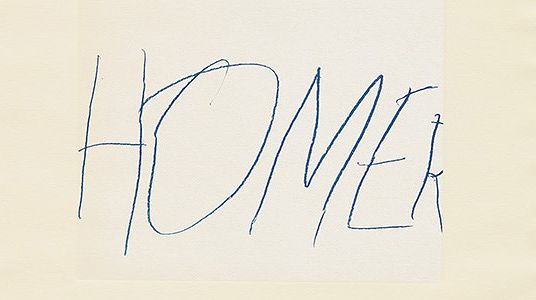Detail from Cy Twombly Five Greek Poets and a Philosopher, 1978
Cy Twombly admired the graffiti of ancient Greece and Rome. Ever since childhood, he had idolized classical wordsmiths who made marks both within their time and upon future generations. After working as an archaeological excavator and traveling through the ancient world with Robert Rauschenberg, Twombly recognized that street tagging of ancient artists, imperial ruins and antiquarian literature were all a kind of mark-making, whether upon Mediterranean cityscapes or the western psyche.
Robert Rauschenberg Cy + Relics—Rome, 1952. This photograph by Robert Rauschenberg of friend and fellow artist Cy Twombly was recently offered in 'A Constant Pursuit: Photographs from the Collection of Ed Cohen & Victoria Shaw', a New York auction at Phillips.
Lured by a lifestyle, the Virginia-born artist moved to Italy in 1957. His work was increasingly literary once he returned to New York. Canvases bore more notable signatures, and fragments of poetry—sometimes the names of writers themselves—became common in his works. Art critic Roberta Smith explained that "Cy Twombly is a great painter, but sometimes it seems even more accurate to describe him as a great writer."
Five Greek Poets and a Philosopher, 1978, served as both artifact and oracle, revealing its artist's past and offering clues about his future. Between 1977 and 1978, Twombly's attention was split between The Illiad and a forthcoming retrospective at the Whitney Museum of American Art, New York, as he produced Fifty Days at Illiam, a new multi-canvas historical painting of the Trojan War. The seven lithographs of Five Greek Poets and a Philosopher were an ode to Twombly's ancient heroes and anticipated group paintings that became his hallmark during the 1980s.
Cy Twombly is a great painter, but sometimes it seems even more accurate to describe him as a great writer.
— Roberta Smith on Cy Twombly
Cy Twombly Five Greek Poets and a Philosopher, 1978. The complete set of seven lithographs (six in colors) with embossment, on Richard de Bas mould-made paper.
Because the medium was technical and required restraint, Twombly was not a prolific printmaker. Yet, the printmaking process proved fertile ground for a deep experimentation with typology. He declared "every line is the present experience of its own inherent history."
His printmaking practice focused on written words; by etching the names of ancient linguistic masters in this set of seven lithographs, he dug straight at the source.


